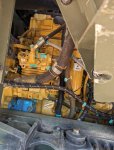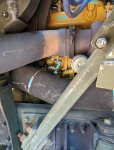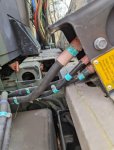Also I procured this I don't see why I can't make it work.
Find many great new & used options and get the best deals for Oshkosh M1070 HET NEW OEM Transfer Case P/N 3359550 at the best online prices at eBay! Free shipping for many products!
www.ebay.com
Your going to have to take a hard look as I stated earlier if the metal housing on the top front part of the transfer case will clear the cab mounts/ cab. From forums I have read there may not be enough space for it.
I got a hold of a fire department that has one and they told me the wheel and tire size of the tires they have on the rear axles and it’s actually a 22.5 inch wheel on the firetruck. Problem is I don’t know where to get the wheel. You could use Alcoa 833587 it's a 22.5x13 wheel $600 plus each...
www.steelsoldiers.com
A quick read from which I gained my information.
Answer to your air brake question:
Your gear driven air compressor off of the engine supplies air for the entire vehicle. This is stored in usually 3 tanks: Primary, Secondary, and Wet. Primary and secondary are two isolated air systems for rear and front brakes. So if one were to fail you would still have the other. The air in both of these tanks have been dried by an air dryer. The wet tank is before the air dryer thus named the wet tank. I believe CTIS is run off of this tank or could be the secondary tank. Common problem I have found on LMTVs are that the tractor protection valve for the trailer air brakes goes bad and allows lots of air to go past. Have someone go to the drivers side intermediate axle tire while depressing the brake pedal and listen to see if the air leaking noise is loudest there. It could also be a faulty brake can.
Link to
@Elijah95 video on how to fix it:
Answer to CTIS:
Some basics to CTIS. Truck needs to be at 120 psi for the system to start. Then your tank pressure sensor will send a signal to your controller saying it is at pressure. Then Your controller will send a signal to some solenoids in your PCU (pneumatic control unit) which sends a 7-10 psi "check" pressure to your wheel valves. The wheel valves will open and tire pressure will rush into the PCU and the pressure transducer in the PCU will tell the controller what the tire pressures are. The system will then decide either to inflate or deflate depending on the pressure. To deflate it will send a 7-10 psi stream of air to the wheel valves to keep them open which will allow the air from the tires to escape out of the quick release valves above the axles. It will stop after about 60 seconds of this and check the pressure and go from there. To inflate it will send pressure from the wet tank to the tires at about 100 psi or so until the tank pressure drops below a certain point then it will stop and wait for more air pressure to start the process again.
The right side of the ctis controller is your terrain modes. The left side is your load in or on your truck at said terrain mode. The controller takes into account your terrain and load and makes a pressure from there. On the door panel there is a spec sheet of what pressures they are supposed to be at for what modes but I cannot find a picture of it. Set the controller for your desired terrain you will be on then your weight you are carrying.
CTIS should at idle take a while to fully fill your tires up. When the system gets your tires to the proper air pressure it will have a solid terrain and load light rather than flashing.
Linked is the CTIS troubleshooting guide for your reading pleasure:
Answer to TIM:
Linked is
@Elijah95 video on the TIM:
Hope this is helpful.







